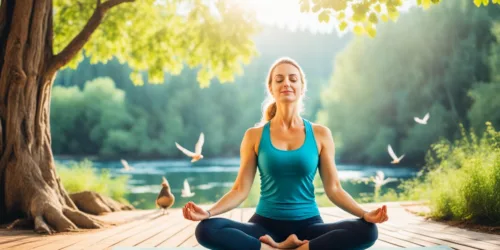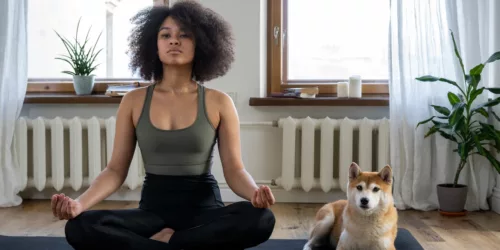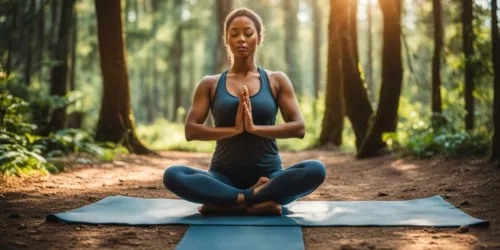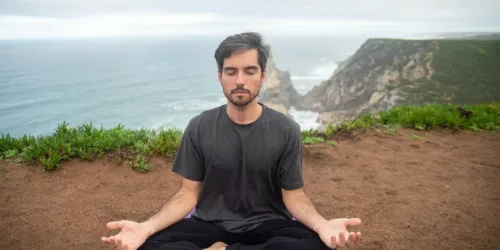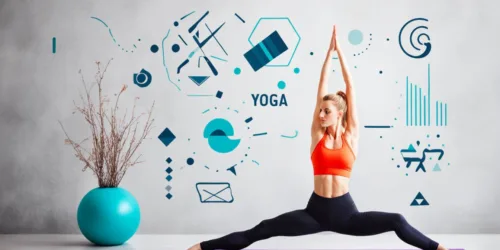How Long Does It Take to Get Good at Yoga: Seeing Results Through Consistent Yoga Practice
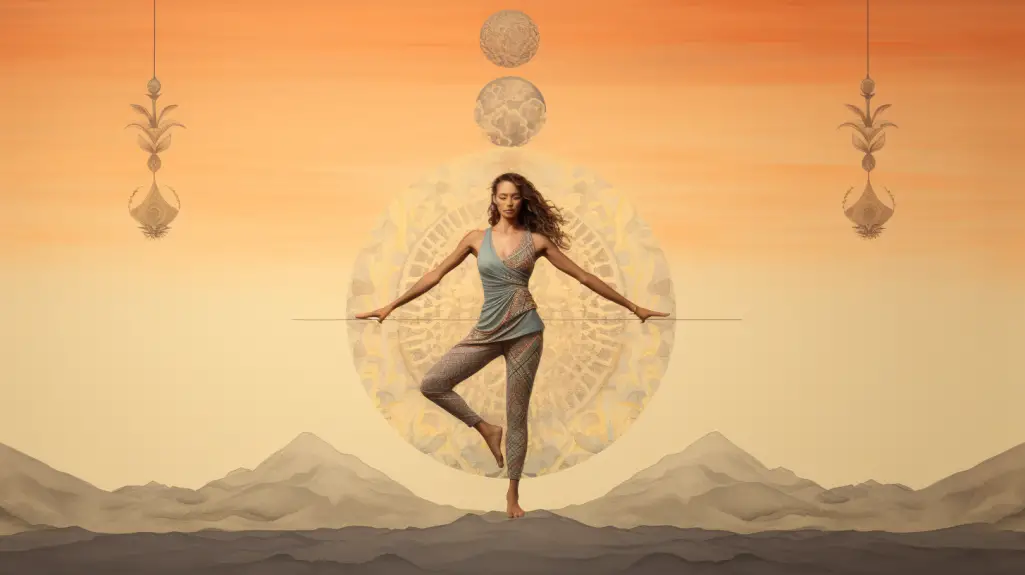
Embarking on a journey into the world of yoga can often come with questions: “How long does it take to see the benefits of a regular yoga practice? Can I get in shape or get flexible through yoga?” This article dives deep into these questions and more, offering clarity on the path of yoga. For anyone pondering how much yoga it takes to notice a difference, whether you’re a beginner or someone revisiting the practice, this piece holds valuable insights.
Key Takeaways
- Yoga is a journey, not a destination. The benefits, both mental and physical, come with consistent practice over time.
- Factors like the type of yoga, frequency of practice, and individual differences play a role in how soon one sees results.
- While certain yoga styles like hot yoga can offer accelerated results, it’s essential to choose a style that aligns with one’s personal needs and health considerations.
- Whether practicing at home or in a studio, what’s most important is regular practice and dedication.
How Long Does It Take to See Results from Yoga Practice?
“Long does it take” is a question many yoga beginners ponder. Yoga is a practice rooted in patience, dedication, and self-awareness. The time it takes to see results from a consistent yoga practice can vary for each individual. On average, if one practices yoga regularly, improvements in posture and flexibility can be observed within 3 to 6 weeks. However, the deeper benefits of yoga, such as enhanced mental and physical health, often take a more extended period to manifest.
Factors such as the style of yoga, the frequency of your practice, and your initial fitness level play a crucial role in the time it takes to see noticeable progress.
What Determines the Pace of Your Progress in Yoga?
Several factors determine how quickly you’ll progress in your yoga journey:
- Frequency of Practice: Practicing yoga multiple times a week, for instance, five times a week, can lead to faster results compared to attending a class once a week.
- Style of Yoga: Intense styles like Ashtanga yoga, power yoga, or Bikram yoga tend to offer quicker physical results. In contrast, restorative yoga or yin yoga focuses on relaxation and flexibility.
- Prior Fitness Level: If you’ve been active or have done yoga in the past, you might progress faster than someone who is entirely new to physical activity.
- Dedication and Mindset: Yoga is a practice, emphasizing that it takes time and dedication. Adopting a growth mindset helps in enjoying the journey more than rushing towards a destination.
How Often Should You Practice Yoga to Get Good?
For beginners, integrating yoga into your routine 2-3 times a week can be an excellent starting point. This allows you to gradually build flexibility, strength, and stamina. It’s also important to note that it’s not just about the number of times you practice, but the quality of each yoga session.
Some research suggests that it takes just 21 hrs of practice to learn the basics of any new skill, but when it comes to yoga, the journey is continuous. A once-a-week yoga class can still offer benefits. However, practicing more frequently, like twice a week or more, can significantly accelerate the results.
Remember, everyone’s body is different, and the time it takes for one individual to feel they are good at yoga may vary from another person’s experience. Whether it takes you a year or a lifetime, the practice of yoga offers rewards at every step.
Can Yoga Help You Get in Shape?
Absolutely! Yoga isn‘t just about flexibility and mental calmness; it’s also an effective way to get in shape. Regular yoga practice involves a series of postures and breathing exercises that work on your core, legs, arms, and even the cardiovascular system.
- Strength: Many yoga poses, especially those that require balancing, build muscle tone. Poses like Plank, Chaturanga, and Warrior series can boost upper body strength.
- Flexibility: Asanas like Downward Dog, Pigeon Pose, and Hamstring stretches increase range of motion and improve flexibility.
- Cardiovascular Health: Faster-paced yoga styles, such as Vinyasa or Ashtanga, get the heart pumping, helping improve cardiovascular health.
The Role of Different Types of Yoga in Your Progress
There are numerous types of yoga, each with its unique set of benefits. Choosing the right style can play a pivotal role in how quickly you progress and the results you achieve.
| Type of Yoga | Primary Benefit | Best For |
|---|---|---|
| Hatha Yoga | Balanced approach to flexibility and strength | Beginners looking to learn basics |
| Vinyasa Yoga | Cardiovascular and strength-building | Those wanting a more dynamic, flow-based practice |
| Yin Yoga | Deep tissue and flexibility work | Individuals looking for relaxation and deep stretching |
| Restorative Yoga | Relaxation and mental peace | Those needing stress relief and gentle poses |
| Hot Yoga (like Bikram) | Detoxification and increased flexibility | Adventurous souls and those looking to sweat |
| Iyengar Yoga | Alignment and posture precision | Anyone looking to refine their postures |
Home Yoga vs. Yoga Studio: Which is Best?
Deciding between home yoga and attending a studio class often boils down to personal preferences, goals, and circumstances. Here’s a brief comparison:
| Aspect | Home Yoga | Yoga Studio |
|---|---|---|
| Environment | Comfort of your space, more personal | Social setting, vibrant energy, dedicated space |
| Guidance | Relies on apps, videos, or self-guidance | Direct input from a yoga instructor |
| Flexibility | Practice anytime | Fixed schedules, variety of classes |
| Cost | Usually cheaper (free online resources) | Membership or class fees, offers amenities |
While home yoga offers convenience and flexibility, studio classes provide guidance from certified yoga teachers and the energy of a group setting.
10 Yoga Poses That Can Expedite Your Progress
For those eager to progress swiftly, focusing on some key poses can be beneficial. Here are ten yoga poses, along with their primary benefits:
- Downward Dog: Enhances hamstring flexibility and upper body strength.
- Warrior I & II: Strengthens legs and boosts stamina.
- Tree Pose: Improves balance and strengthens the core.
- Plank Pose: Builds core strength.
- Triangle Pose: Stretches the sides and strengthens legs.
- Bridge Pose: Strengthens the back and glutes.
- Crow Pose: Enhances upper body strength and balance.
- Camel Pose: Opens the chest and stretches the front body.
- Child’s Pose: Calms the mind and lightly stretches the back.
- Pigeon Pose: Opens up hip flexors and boosts flexibility.
Does Hot Yoga Offer Faster Results?
Hot yoga, popularly associated with Bikram Yoga, involves practicing in a heated room—typically around 105°F (40°C) with 40% humidity. This style has gained significant attention for its potential accelerated benefits.
Pros of Hot Yoga:
- Detoxification: The intense sweat is believed to help flush toxins from the body.
- Increased Flexibility: Warm muscles are more pliable, which can make it easier to stretch and attain deeper postures.
- Cardiovascular Challenge: The heat intensifies the workout, pushing your heart to work harder.
However, hot yoga may not be suitable for everyone, especially those with specific health conditions. It’s essential to stay hydrated and listen to your body during sessions.
Consistent Yoga Practice: The Key to Mastery
Consistency is the cornerstone of any discipline, and yoga is no exception. While the initial stages might involve learning the basics, deepening your yoga practice involves dedication over time.
- Mind-body Connection: Over time, regular yoga practice fosters a stronger mind-body connection, enhancing self-awareness and mindfulness.
- Physical Progress: With consistent practice, you’ll notice improved flexibility, strength, and balance.
- Mental Benefits: Long-term practitioners often report better stress management, mental clarity, and emotional balance.
It’s vital to remember that the journey of yoga isn’t just about achieving a particular pose but about the insights and growth experienced along the way.
FAQs: Common Queries About Getting Good at Yoga
- How long does it take to get flexible with yoga?
Flexibility gains can start to be noticed as early as 3 to 6 weeks into regular practice. However, factors like age, genetics, and the type of yoga practice influence the pace. - Can I start yoga if I’m not flexible?
Absolutely! Yoga is for everyone. Saying you’re too inflexible for yoga is like saying you’re too dirty to take a bath. Over time, yoga can help you become more flexible. - How many times a week should a beginner practice?
For a beginner, practicing 2-3 times a week is ideal. However, listening to your body and ensuring you get adequate rest is crucial. - Does yoga help in weight loss?
While yoga isn’t a high-intensity workout, it can aid weight loss by enhancing mindfulness, reducing stress, and improving muscle tone.
Conclusion
Embarking on the path of yoga is a transformative journey. Whether your goals are physical, mental, or spiritual, the practice offers a plethora of benefits that evolve over time. Celebrate every milestone, small or big, and remember that every yogi’s journey is unique. Namaste.


